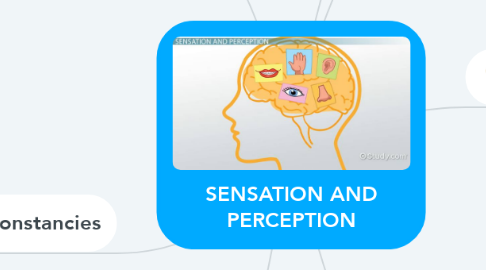
1. Definition of Sensation
1.1. Sensation is defined as the simplest of all conscious experience (Douglas and Holland)
2. Definition of Perception
2.1. The active process of selecting, organizing and interpreting the information brought to the brain by the senses (Solomon,2006)
3. Basic Concepts of Sensation and Perception
3.1. All our senses-
3.1.1. 1. Receive sensory stimulation often using specialised receptor cells
3.1.2. 2. Transform the stimulation into neural impulses
3.1.3. 3. Deliver the neural information to our brain
3.2. Transduction and Synesthesia
3.2.1. Transduction is the process of converting outside stimuli, such as sights,sounds and smell into neural impulses our brain can interpret
3.2.2. Synesthesia is the disorder in which the signals from various sensory organs are processed in the wrong brain areas, resulting in information being interpreted as more than one sensation
3.3. Sensory Threshold (Pioneer- Ernst H Weber)
3.3.1. Absolute Threshold
3.3.1.1. The lowest level at which a stimulus can be detected
3.3.2. Recognition Threshold
3.3.2.1. The level at which a stimulus can not only be detected but also recognized
3.3.3. Differential Thershaold
3.3.3.1. The level at which an increase in a detected stimulus can be perceived
3.3.4. Terminal Threshold
3.3.4.1. The level beyond which a stimulus is no longer detected
4. Perceptual Constancies
4.1. Size Constancy
4.1.1. Recognition that an object remains the same even when they move farther away
4.2. Shape Constancy
4.2.1. Perceiving objects as having a stable or unchanging shape regardless of changes in the retinal image resulting from differences in viewing angle
4.3. Brightness Constancy
4.3.1. The brightness of the object is perceived to be constant, even though changes in illumination make the objects appear brighter or lighter
5. Gestalt Principles
5.1. 1. Proximity
5.2. 2. Similarity
5.3. 3. Symmetry
5.4. 4. Closure
5.5. 5. Continuity
5.6. 6.Pragnanz/Law of Good figure
5.7. 7.Law of figure and Ground
6. Depth Perception
6.1. Binocular Cues
6.1.1. Cues that depend on the combination of images of the Left and the right retinas
6.1.2. Types
6.1.2.1. Retinal Disparity
6.1.2.2. Convergence
6.2. Monocular Cues
6.2.1. These cues judge the distance of the only using one eye
6.2.2. Types
6.2.2.1. Familiar Size
6.2.2.2. Height in the feild of view
6.2.2.3. Linear Perspective
6.2.2.4. Shading
6.2.2.5. Texture Gradient

